BWW Dance Review: Joaquin De Luz's Final Performance at New York City Ballet.

I'm not sure if one can even review Joaquin de Luz's farewell performance at New York City Ballet on October 14, 2018. It was a love-in, a blast, a theatrical happening, you name it--a loud, overpowering, shower of love for one of City Ballet's most irresistible and charismatic dancers. Luckily, many of his performances were filmed, so we can always look back. Still, it's not the same as watching a performer literally soar across the stage to thunderous applause. But what can we do?
De Luz's repertoire in both Balanchine and Robbins has been huge and vastly different: Ballo della Regina, Coppélia, A Midsummer Night's Dream, "Rubies" from Jewels, La Source, Tschaikovsky Pas de Deux, Tarantella, Theme and Variations, Dances at a Gathering, Fancy Free, Other Dances, and A Suite of Dances, as well as originating roles by other choreographers, including Warren Carlyle, Jorma Elo, Wayne McGregor, Justin Peck, Alexei Ratmansky, and Christopher Wheeldon.
As a going away present for the audience, he danced Balanchine's Theme and Variations, Jerome Robbins' A Suite of Dances and Peter Martins' Todo Buenos Aires.
Theme and Variations, originally created by Balanchine for ABT in 1947 to the final movement of Tschaikovsky's Suite No. 3 for Orchestra in G major, Op. 55, seems, at first, like a throwback to his childhood Mariinsky days. But look again and you'll see that those dancers could never have executed any of the steps in Balanchine's youth. There are too many hurdles to overcome in technique and presentation. De Luz and Tiler Peck, dancing the female lead, had no such problems. Everything was tossed off neatly and with a smile on their faces. This is a problem? Nonsense. Even Balanchine and Tschaikovsky would have been impressed.
Balanchine's Concerto Barocco, first created in 1941 to the music of Johann Sebastian Bach's Double Violin Concerto in D minor, is one of City Ballet's glories. Since City Ballet's opening night on 1948, it has never been out of the repertoire. It has dazzled, perplexed and won audiences all over the world, and I imagine that long after we are gone it will still be around. It's just over 20 minutes of intense, labyrinthian movement that never stalls. It's almost perfect. Actually I should say it is perfect.
Maria Kowroski and Abi Stafford were both outstanding in the two female leads, and Russell Janzen, as the only male dancer who appears in the entire ballet, lifted Kowroski with such suppleness, that I was wondering if he could be City Ballet's answer for Conrad Ludlow, a former principal who retired many years ago, but who has never been equaled as a partner.
A Suite of Dances, a very fine, contemplative solo work by Jerome Robbins to selected movements from the Six Suites for Solo Cello, was first choreographed in 1994 for Mikhail Baryshnikov. I remember seeing it and being impressed by its easy-going charm, but wondered if perhaps Baryshnikov was not the right dancer for it. Baryshnikov was already a mature dancer, but the ballet's movements, its overall theme of youth in its glory, its wonderment at the universe, called for a younger, seemingly innocent but questing person. To me, it seemed like a perfect vehicle for Taylor Stanley, whose pure liquid technique and innocent face are tailor-made for the role. I hope he'll dance it one day, as he will the Boy in Brown in Dances at a Gathering.
De Luz was charming, passionate, but the pesona was not right. He's bursting at the seams; the dances here are reflective, self involved; Even as he's flying he is grounded, almost troubled. The dancer in this ballet is very much of this earth. Ann KIm on the cello played beautifully and was always alert to the movement, yet there could have been a deeper, burnished tone. The two were always disconnected, trying to catch up with their souls. But it could never be accomplished.
The celebration concluded with Todo Buenos Aires, a work by Peter Martins that I have not seen before and presented for the sole reason of showing De Luz being sexy in a tango environment. (You didn't have to do this--almost everyone in the audience knew already.)
Still, it gave de Luz the opportunity to dance with Sara Mearns and Maria Kowroski, while having a blast with four other principal male dancers, Jared Angle, Ask la Cour, Taylor Stanley, and Andrew Veyette.
And that was it. The applause and screaming began. Everyone came on the stage bringing flowers and good wishes. My favorites was Maria Kowroski, who embraced de Luz a la Prodigal Son, her foot wrapped around his torso and her hand raised in glory; and the mother of de Luz, who spent a few seconds dancing with him.
De Luz kneeled and kissed the theater's floor--the curtain fell.
Thank you, Mr. De Luz. It has been wonderful knowing you. I wish you the best of luck in all your future endeavors.
Until we meet again.
Photo: Paul Kolnik
Reader Reviews
Videos

